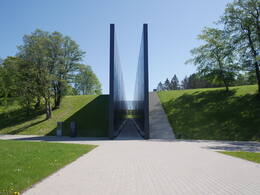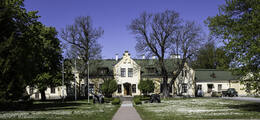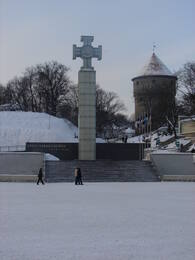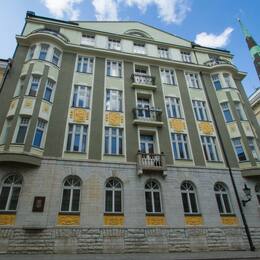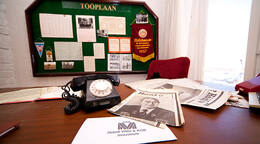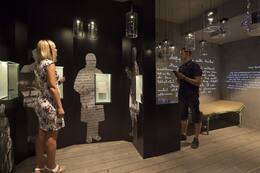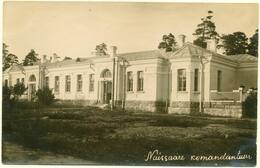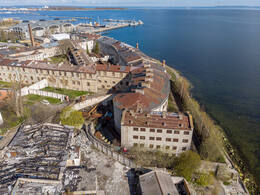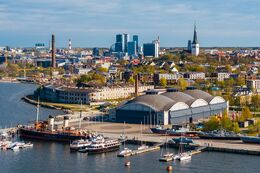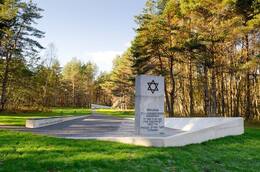Gyvenimas Estijoje sovietų okupacijos metu
Estijos komunizmo aukų memorialas
Memorialas yra Maarjamäe rajone, Taline. Antrojo pasaulinio karo metu ir dėl okupacinio režimo kurstomo teroro Estija neteko kas penkto savo gyventojo.
Komunizmo aukų memorialas skirtas daugiau nei 75 000 estų, kuriuos nužudė, įkalino arba deportavo sovietų valdžia.
Jį sudaro dvi dalys: „Kelionė“ su aukų vardų lentelėmis; ir simbolinis „Namų sodas“ su informaciniais tekstais ir akmeninėmis lentelėmis, žyminčiomis teroro vietas.
Estijos Karo muziejus – generolo Laidonero muziejus
Šis muziejus, nuo 2001 m. įsikūręs XIX a. vidurio istoristiniame Viimsi dvare, atlieka tyrimus, saugo ir eksponuoja Estijos karinę istoriją. Jo pirmtakai buvo Estijos išsivadavimo karo muziejus (įkurtas 1919 m. sausio 19 d.) ir generolo Laidonerio muziejus, įkurtas dvare 1993 m. Viimsi savivaldybės valdžios dekretu. Sovietų okupacijos metu dvare veikė karinio jūrų laivyno žvalgybos dalinys: pasitraukus sovietų armijai, pastato būklė buvo apgailėtina. Muziejus buvo įkurtas gynybos ministro Jüri Luiko dekretu 2001 m. vasario 26 d. Nuo tada muziejus veikia Gynybos ministerijos jurisdikcijoje. Pagrindinėje jo ekspozicijoje pristatomi Estijoje ir užsienyje vykę karai, kuriuose dalyvavo estai. Dalis parodos skirta vyriausiajam vadui Johanui Laidoneriui, kuriam dvaras priklausė nuo 1923 iki 1940 m. Karinės technikos angare šalia pagrindinio pastato eksponuojami įvairūs artilerijos pabūklai ir transporto priemonės.
KGB kalėjimo kameros
Šis muziejus įsikūręs buvusių NKVD ir KGB būstinių rūsyje Talino centre.
Pagari gatvėje 1 esančiame pastate buvo įsikūręs vienas liūdniausiai pagarsėjusių ir baisiausių sovietmečio tardymo izoliatorių, kuriame buvo kankinami ir mirties bausme arba kalėjimu nuteisti daugybė Estijos politikų, valstybės pareigūnų, intelektualų, Nepriklausomybės karo veteranų ir net paprastų žmonių. Nepertvarkytos kameros yra Raudonojo teroro įsikūnijimas ir dabar atviros lankytojams. Muziejų sudaro du koridoriai, šešios kalėjimo kameros ir viena vienutės kamera. Pagrindinė ekspozicija, pavadinta „KGB rūmų istorija“, primena ten įvykdytus žiaurumus.
Šis adresas turi įdomią praeitį. 1912 m. čia pastatytas gyvenamasis pastatas Nepriklausomybės karo metu buvo Estijos laikinosios vyriausybės ir karinės vadovybės būstinė. Vėliau, iki 1940 m., pastate buvo įsikūrusi Estijos Respublikos karo ministerija. 1991 m. kovo mėn. pastatas tapo Estijos policijos pagrindiniu būstiniu. Šiandien Pagari gatvė 1 vėl naudojasi savo buvusia gyvenamąja paskirtimi.
Viešbutis „Viru“ ir KGB muziejus
Viešbutis „Viru“ Taline buvo pastatytas 1972 m. Užsieniečiams skirtas viešbutis taip pat turėjo atitikti nacionalinio saugumo institucijos – KGB – reikalavimus. Muziejus pasakoja ne tik vieno viešbučio ir KGB istoriją. Tai dviejų skirtingų pasaulių istorijų lobynas – vienas, kuris egzistavo daugiausia popieriuje, apie laimingus sovietinius piliečius, gyvenančius draugiškai ir nieko nestokojančius, vadovaujamus išmintingos, visagalės vyrų grupės vietoje, kur niekada nebuvo jokių nelaimingų atsitikimų ar katastrofų; ir kitas realus pasaulis, kuris buvo visai kitoks ir daug sunkesnė vieta gyventi.
Norėdami apsilankyti muziejuje, prašome užsiregistruoti iš anksto.
Vabamu okupacijų ir laisvės muziejus
Vabamu muziejus yra Talino centre.
Privatus muziejus, atidarytas 2003 m., skirtas pristatyti Estijos istoriją nuo 1940 iki 1991 m. Muziejus prisimena nesenos istorijos istorijas, pabrėžiančias laisvės vertę ir trapumą.
Pagrindinė ekspozicija ir muziejuje rodomi filmai suteikia apžvalgą apie sovietinę okupaciją, priespaudą, nacionalinį pasipriešinimą ir Dainuojančią revoliuciją.
Pagrindinė paroda „Laisvė neturi ribų“ suskirstyta į penkias temas: „Nežmoniškumas“, „Tremtyje“, „Sovietų Estija“, „Restauracija“ ir „Laisvė“. Muziejaus lankytojai gali dalyvauti garso ture (estų, rusų, anglų, suomių, vokiečių, prancūzų arba ispanų kalbomis), kuris padės jiems leistis į šią įtraukiantį ir retrospektyvų pasakojimą apie istoriją. Taip pat yra užsiėmimų vaikams, kurie suteiks nepamirštamą patirtį visai šeimai.
Naisaro sala
Šią 19 kvadratinių kilometrų ploto salą Talino įlankoje 1912 m. įsigijo Rusijos imperatoriškasis karinis jūrų laivynas, išstumdamas vietinius gyventojus. Karinis jūrų laivynas saloje pastatė uostus, geležinkelius ir pakrantės baterijas kaip Petro Didžiojo jūrų tvirtovės dalį. Pirmojo pasaulinio karo ir Nepriklausomybės karo metu saloje taip pat buvo karo belaisvių stovykla. Naujai nepriklausoma Estijos Respublika išlaikė salą kaip sukurtos pakrantės gynybos sistemos dalį, tačiau leido vietos gyventojams į ją grįžti. Sovietų okupacijos metu salą kontroliavo kariškiai, kurie joje pastatė jūrų minų depą ir gamyklą. Naisare sovietų armijos paliktus pastatus ir įrangą vis dar galima iš dalies apžiūrėti ir šiandien. Jūrų tvirtovei suformuotas bunkerių tinklas driekiasi giliai po žeme. Kai kurie bunkeriai ir artilerijos atramos vis dar prieinami. Visą salos apžvalgą galima atlikti per dieną. Saloje anksčiau buvo tankus geležinkelių tinklas, jungiantis karinius objektus. Štai kodėl likę takai yra puikus vadovas keliaujant po salą.
Naisare yra 40 kilometrų siaurojo geležinkelio, kurio tiesimas pradėtas 1913 m., caro laikais. Geležinkelio tinklas buvo iš dalies naudojamas ir nepriklausomybės laikais, ir sovietų okupacijos metu. Šiandien atkurta 2,4 kilometro ilgio jo atkarpa. Pakrantės žmonių muziejuje salos lankytojams eksponuojamos įvairios parodos, kuriose galima išsamiau susipažinti su salos istorija. Männiku kaime, sovietmečio karių gyvenamuosiuose namuose, eksponuojama karinė paroda, kurioje pristatoma tiek ankstesnė, tiek naujausia salos karinė praeitis. Naisare švyturyje veikia paroda „Naisaras ant senų atvirukų“, kurioje vaizduojama sala jos klestėjimo laikais.
Patarei jūros tvirtovė
Buvusi jūrų tvirtovė, esanti Talino Kalamajos rajone.
Karo inžinierių Étienne-Louis Boullée ir Claude-Nicolas Ledoux suprojektuotas Patarei tvirtovės statybas 1829 m. pradėjo vykdyti Rusijos imperatorius Nikolajus I. Kompleksas buvo atidarytas 1840 m., tačiau tai nereiškė, kad statybos darbai buvo baigti. Tvirtovė buvo renovuota: buvo baiminamasi, kad po Krymo karo pradžios 1853 m. britai ir prancūzai puls iš Baltijos jūros. Tai iš tiesų įvyko, tačiau į didelio masto karą tai neperaugo. Iš Patarei buvo paleisti tik keli šūviai. Pradėjus naudoti sprogstamuosius sviedinius, Patarei tvirtovė 1858 m. buvo uždaryta ir vėliau naudojama kaip kareivinės. Estijos nepriklausomybės laikais Patarei buvo paverstas kalėjimu, kuris veikė iki 2002 m. Jis taip pat buvo naudojamas kaip kalėjimas vokiečių ir sovietų okupacijų metu. Šių režimų čia įvykdyti žiaurumai šią vietą pavertė liūdnai pagarsėjusia tarp gyventojų. Architektūriškai iškiliame keturių hektarų pastate dabar įrengta paroda pavadinimu „Komunizmas yra kalėjimas“, kurioje dėmesys skiriamas komunistinei ideologijai, komunistiniams nusikaltimams ir pastato istorijai. Šio nuostabaus architektūros stebuklo, apimančio keturis hektarus, renovacija prasidėjo 2020 m. Iki 2026 m. „Patarei“ taps integruotu urbanistiniu kraštovaizdžiu su komercinėmis patalpomis, gyvenamosiomis patalpomis ir laisvalaikio praleidimo galimybėmis. Rytiniame pastato sparne bus išsaugotas originalus kalėjimo interjeras ir mankštos aikštelės. Jau dabar veikia beveik 1200 kvadratinių metrų ploto paroda apie komunistinę ideologiją, žiaurumus ir pastato istoriją.
Hidroplanų uostas
Vandens lėktuvų uostas yra įsikūręs ant vandens krašto, Talino Kalamajos rajone.
Jį Pirmojo pasaulinio karo metu užsakė Rusijos imperatorius Nikolajus II kaip Petro Didžiojo jūrų tvirtovės dalį. Muziejuje, įsikūrusiame istoriniame hidroplanų angare, eksponuojama apie 200 originalių eksponatų: povandeninis laivas „Lembit“, 100 metų senumo ledlaužis „Suur Tõll“, hidroplanas „Short 184“, seniausias Estijos laivo nuolaužos, minos, patrankos ir kt. Pagrindinę parodą papildo laikinos parodos. Hidroplanų angaras yra architektūriškai unikalus: jo kupolinis stogas buvo viena pirmųjų tokio tipo plonų betoninių kevalinių konstrukcijų.
Muziejaus programos ir medžiaga individualiems apsilankymams yra smagios ir edukacinės tiek suaugusiems, tiek vaikams.
Klogos koncentracijos stovykla ir holokausto memorialas
Šis Holokausto aukų memorialas yra netoli nedidelio Kloogos miestelio.
Pirmasis paminklas čia buvo pastatytas 1951 m., tačiau jame iš esmės buvo šlovinama sovietinė ideologija ir mažai dėmesio skirta Holokausto aukoms atminti. 1994 m. Estijos žydų bendruomenės prašymu paminklo lentelės buvo pakeistos naujomis, siekiant pagerbti aukų etnines šaknis. Minint 50-ąsias masinių žudynių Kloogoje metines, 100 metrų atstumu nuo pirmojo paminklo buvo atidengtas paminklas 1941–1944 m. Estijoje nužudytiems žydams. 2005 m. buvo atidengtas trečiasis paminklas, skirtas atminti Kloogos koncentracijos stovykloje žuvusius ar nužudytus žydus.
Memorialas buvo renovuotas 2013 m., siekiant sujungti tris paminklus, o Estijos istorijos muziejus čia atidarė lauko parodą pavadinimu „Kloogos stovykla ir Holokaustas“.
Kloogos koncentracijos stovyklą vokiečių režimas įkūrė 1943 m. rugsėjį. Tai buvo priverstinio darbo stovyklos dalis, priklausanti Vaivaros koncentracijos stovyklos kompleksui Estijoje. 1944 m. rugsėjo 19 d. buvo įvykdyta viena didžiausių masinių žudynių vokiečių okupuotoje Estijoje: artėjant Raudonajai armijai buvo nužudyti visi stovykloje buvę žydai (iš viso apie 2000).
Paldiskis
Paldiskis (istoriškai žinomas kaip Rågervik) yra Estijos šiaurinėje pakrantėje, Pakri pusiasalyje.
Jis buvo svarbus uostas nuo Didžiojo Šiaurės karo laikų. 1718 m. Rusijos imperatorius Petras Didysis įsakė čia pastatyti įtvirtintą jūrų uostą ir kitus karinius objektus, paversdamas miestą viena svarbiausių imperijos karinio jūrų laivyno bazių.
Tarpukario Estijos nepriklausomybės laikotarpiu vasaromis Paldiskis buvo šarvuotų traukinių mokymo vieta. Dėl 1939 m. Sovietų Sąjungos Estijos Respublikai primestos savitarpio pagalbos pakto Paldiskis atiteko Raudonosios armijos kontrolei. Buvo įkurta Paldiski karinio jūrų laivyno bazė ir pastatyti tolesni įtvirtinimai. Paldiski regionas turėjo didelę reikšmę Raudonosios vėliavos Baltijos laivyno pakrantės gynybos sistemoje. Septintajame dešimtmetyje Paldiski buvo atidarytas vienas iš trijų Sovietų Sąjungoje esančių atominių povandeninių laivų mokymo centrų (įrengtas atominio povandeninio laivo maketas). Miestas ir Pakri salos buvo uždaryti visuomenei ir laikomi paslaptyje. Paldiski turėjo du branduolinius reaktorius, kurie vėliau buvo įbetonuoti.
Sovietmečio pastatai Paldiski mieste tapo retenybe. Petro Didžiojo jūrų tvirtovės bastionai atviri turistams: https://visitharju.ee/et/node/9682.




